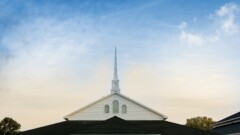I know that it is bad form to turn a sermon into a blog post, but I’m going to do it anyway (hey, it’s my blog!). Yesterday I preached from Genesis 3 and found great joy in going from the garden to the cross. There are lots of ways we can do this, but I chose to do it through the cherubim. Can I ask you to read along? I think you’ll find this a real encouragement.
By the end of Genesis chapter 3, the Lord has passed judgment on the serpent, on the woman and on Adam and he has banished them from the Garden of Eden–banished them from his presence and from the place where they could have access to the tree of life from which they could eat and live forever as sinful immortal beings. Before the entrance, to ensure they could never return to the garden, he placed a flaming sword and the cherubim.
What is a cherubim? Cherubim have gotten a bit of a bad rap, I think. When we think of cherubs we tend to think of cute, pudgy little angels that help children go to sleep. According to the Bible, though, the cherubim are terrifying warriors who are guardians of the things of God. They are described as having the general appearance of men, but also of having the face of a lion or the face of an eagle—fierce creatures, predators. They have wings—sometimes two pairs and sometimes just one. These are creatures who are created specifically to protect and to fight and to destroy. You do not want to meet a cherubim and you do not want your kids to be thinking about them when they are trying to get to sleep!
It was cherubim that were mounted on the top of the Ark of the Covenant; their wings stretched out over the mercy seat. It was from here, from the mercy seat, under the wings of the cherubim, that the Lord spoke to Moses so that in the Old Testament we read of God being the God who is enthroned between the cherubim. These are holy creatures, creatures who are near the presence of God. They aren’t cute; they aren’t pretend. They are powerful, they are strong, they are holy, they will utterly destroy any unholy thing that comes near the presence of God. They are the ultimate guardians. This is their job and they do it with perfection!
Do you see how unholy Adam and Eve have become? How unholy we have become? Between us and God we must now have this kind of a creature to keep us away from him, to guard his presence from our pollution, from our sin.
So there was the Garden and the tree of life—the tree that Adam and Eve and all their children could eat of and live. And now there between them were the cherubim with the flaming sword. The way was barred. No man could now approach God. No man could approach God and eat and live forever. Man must die. He must die and return to the dust from which he was taken. No man could brave those cherubim and live. This is where Genesis 3 ends. But, thankfully, the Bible continues. And as it continues, we meet the cherubim again. So just quickly, let’s follow those cherubim. We will follow them…
…To the Tabernacle
The next place we find those cherubim is in the wilderness. When the Israelites left Egypt and wandered in the wilderness for 40 years, God told them to build a tabernacle, a place of worship.
This tabernacle had a courtyard where all of God’s people could go to perform their sacrifices, to be made right with God. It had an enclosed inner place, the Holy Place, where only the priests could go. And it had a Most Holy Place, the Holy of Holies, where only one man could go, and he only once a year. This was the center of the tabernacle, the pinnacle. This is where the ark of the covenant rested, the ark in which God dwelt between the cherubim. God had dwelt in the Garden of Eden; now God dwelt here in the tabernacle, here in the ark, between the cherubim.
Between the Holy Place and the Most Holy Place was a curtain, a thick curtain of blue and purple and scarlet yarns and fine twined linen. This curtain was meant to keep everyone away—to keep them away from God. And worked into the curtain by the finest artists, was the image of the cherubim. Between God and the people, between God’s people and the presence of God in the Most Holy Place were those cherubim. There on the curtains they declared that they were still the guardians, that they had to keep unholy beings out of God’s presence, that the way was still barred. The Israelites made their sacrifices, they performed what God told them to do, but always they knew that God was hidden behind the curtain, behind the cherubim, away from sinners.
…To the Temple
The years continued to pass. When God’s people captured the land and when the Lord granted them a time of peace, Solomon built the Lord a temple. The tabernacle was for wanderers, but the temple was for people who were now settled in the land of promise, for people who had come home. Like the tabernacle the temple had an outer court for everyone, a Holy Place for the priests, and a Most Holy Place, a Holy of Holies. Inside the Most Holy Place, the place where only the High Priest could go, and could go only once every year, were two huge cherubim, covered with gold, each one 15 feet high and each with a 15-foot wingspan. These cherubim stood side-by-side, wingtip to wingtip, with the Ark of the Covenant between them, under their wings. And once more a curtain divided the Holy Place from the Most Holy Place. It divided God from man. And on that curtain were embroidered those same cherubim, those same fierce warriors. On a blood-colored veil, a thick linen curtain, were the guardians of God. And again, they declared to everyone, to all of God’s people, that the way was barred. You cannot approach God. You cannot stand in his presence. You are an unholy people and the cherubim will strike you down if you dare to approach this holy God.
The message was clear. The cherubim were a picture, an object lesson. God is holy. You are not. The way is shut!
…To the Cross
The temple stood when Jesus walked the earth. He visited the temple when he was a boy. He cleansed the temple during the years of his ministry, driving the money changers away from it. He died on a hill not too far from that temple.
Let me talk about that for just a moment. Jesus declared that he was both God and man, that as God he was free from any sin and that as a human he could fairly represent all other human beings; the man Adam had represented all of us in his sin and now Jesus would be the Second Adam, the second great representative; (we read about this in Romans). He declared that he was going to do something only he could do—exchange our sinfulness for his goodness. He would give us what we do not deserve, what we could not do on our own.
We cannot make ourselves good before God. We need someone to be good for us and to give us his goodness. It can’t come from within so it has to come from without. It has to be a gift. It has to be grace—something that is not owed to us; something we do not deserve. Jesus was good; he did not sin; not even once. And he declared that when he died he would face God’s wrath against sin for everyone who would ever want to be reconciled to God. He would face the curse for sin on our behalf.
And so he was nailed to a cross. And as he hung there he was cursed by God. He suffered not for his own sin like the common criminals beside him—Jesus had no sin!—but for the sin of the people he loved. He hung there until his work was done. And in the moment he died, a remarkable thing happened. He cried out “It is finished!” and then, as he died, as he went to be with his Father, that veil, that curtain that hung in the temple, that curtain embroidered with the image of the cherubim, was torn in two. That heavy curtain was destroyed. In the death of Jesus it was rendered obsolete, useless, passe, abolished.
God tore the curtain in two, declaring that Christ had succeeded. He had done what was necessary. This curtain was not torn from bottom to top by the hand of man, but top to bottom by the hand of God. The cherubim were gone. The flaming sword was gone. They were no longer necessary. They were ripped apart, stitch by stitch.
…To You
Do you see what this does? We no longer have to approach through the cherubim, through the guardians. Between us and God there now stands Jesus, a man like us, a man who calls to us and tells us to come. He says, “I am the way, the truth and the life.” He says, “Come to me, all who labor and are heavy laden, and I will give you rest. Take my yoke upon you, and learn from me, for I am gentle and lowly in heart, and you will find rest for your souls. For my yoke is easy, and my burden is light.”
Man can now approach God. And man can now approach God boldly through Jesus Christ. Think of the letter to the Hebrews where we find these words: “Therefore, brothers, since we have confidence to enter the holy places by the blood of Jesus, by the new and living way that he opened for us through the curtain…let us draw near with a true heart in full assurance of faith.” Suddenly we can come before God, and not with terror and trepidation, but with confidence and with full assurance.
And that is an awesome, amazing thing. That is grace; that is what we do not deserve but so badly need to receive.










